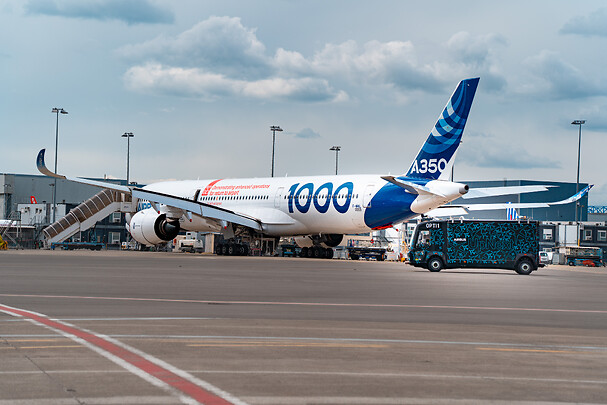Tech
Airbus Presents Optimate: A Next-Generation A350 Cockpit on Wheels

A wholly-owned subsidiary of Airbus, Airbus UpNext, has begun testing new technologies on an innovative electric vehicle in order to support automated taxiing and improve pilot assistance.
The goal of the three-year research project, named Optimate, is to enhance human-machine interaction, flight safety, and aircraft navigation systems by combining a wide range of cutting-edge technologies, such as sophisticated automation, computer vision, data fusion, and machine learning.
Developing and testing automatic taxiing based on more precise and dependable position calculations, as well as evaluating the possibility of using quantum sensing to enhance position availability and navigation system resilience, are important goals of Optimate.
Examining how a virtual flight assistant and collaborative map may help pilots make strategic decisions and communicate with air traffic control and airline operations centres is another goal.
The new architecture and algorithms will be verified on a test bed electric vehicle that can roll along airport runways like an aeroplane and replicates the essential features of an actual aircraft cockpit in order to assist lower CO2 emissions from test operations. With the help of cutting-edge automation technology including the most recent LIDAR and external cameras, together with GPS, satcom, and 5G, it will resemble an A350 cockpit on wheels.
Utilising the virtual assistant for a completely automated gate-to-gate voyage on an A350 flight test aircraft will be the project’s final phase.

Tech
Scientists Create Drone with Fiber Optic “Nervous System” for Smarter Flight

Technology is advancing rapidly, with scientists constantly pushing boundaries. Now, researchers from Southampton have developed a unique drone equipped with its own “nervous system.”
This breakthrough allows the drone to process information and respond to its surroundings more like a living creature, making it faster and more adaptable than ever before.
China Set to Debut New J-35A Stealth Fighter at Zhuhai Airshow
Scientists at the University of Southampton have pioneered a groundbreaking development in drone technology by equipping a drone with its very own “nervous system.” This innovative system, made of fiber optics, enables the drone to function with greater autonomy and efficiency.
Unlike traditional drones, this technology allows the drone to operate for longer periods without needing frequent stops for manual inspections, drastically improving its operational capabilities.
Comparison of the Indian built Tejas MK1A vs South korean FA 50
Developed by Dr. Chris Holmes and Dr. Martynas Beresna from Southampton’s Optoelectronics Research Centre, the drone’s “nervous system” works by using optical fibers to monitor its condition in real-time.
These fibers detect stress and potential faults, sending data back to the ground team, allowing them to spot issues without interrupting the drone’s flight. The system uses a process called optical speckle, which projects images to assess the drone’s status, all while being supported by AI algorithms that interpret these signals for the ground crew.
Initially designed to deliver life-saving equipment like defibrillators in emergencies, this technology has shown promise in enhancing the drone’s longevity and reducing the need for extensive ground crew involvement.
This is especially crucial as the drone industry is projected to contribute up to £45 billion to the global economy by 2030, particularly in sectors like logistics and transportation. The University of Southampton’s team believes that the new system will revolutionize drone operations, making them more reliable, safer, and cost-effective for commercial use.
The technology, which has already been successfully tested on a drone developed by university undergraduates, is set to be commercialized by 2025, with the university’s Future Worlds acceleration programme providing vital support for its development.
-

 Aviation2 months ago
Aviation2 months agoMicrosoft Flight Simulator Raises $3 Million to Bring Back the An-225 Mriya
-

 Airlines2 months ago
Airlines2 months agoQantas Engineers Stage Walkout Over Cost of Living Concerns
-

 Airlines2 months ago
Airlines2 months agoQatar Citizens Can Travel to the United States Without a Visa
-

 Aviation2 months ago
Aviation2 months agoQatar Airways bans these new Electronic Devices on plane
-

 Airlines2 months ago
Airlines2 months agoJapan Airlines Rolls Out Free Domestic Flights to International Passengers
-

 Defence2 months ago
Defence2 months agoWhich Country Has the Largest Fleet of Fighter Aircraft?
-

 Airport2 months ago
Airport2 months agoWestern Sydney Airport Welcomes Its First Plane After 6 Years of construction
-

 Aviation2 months ago
Aviation2 months agoDid you know ? Once Boeing 747 carried 1088 passenger in 1991








